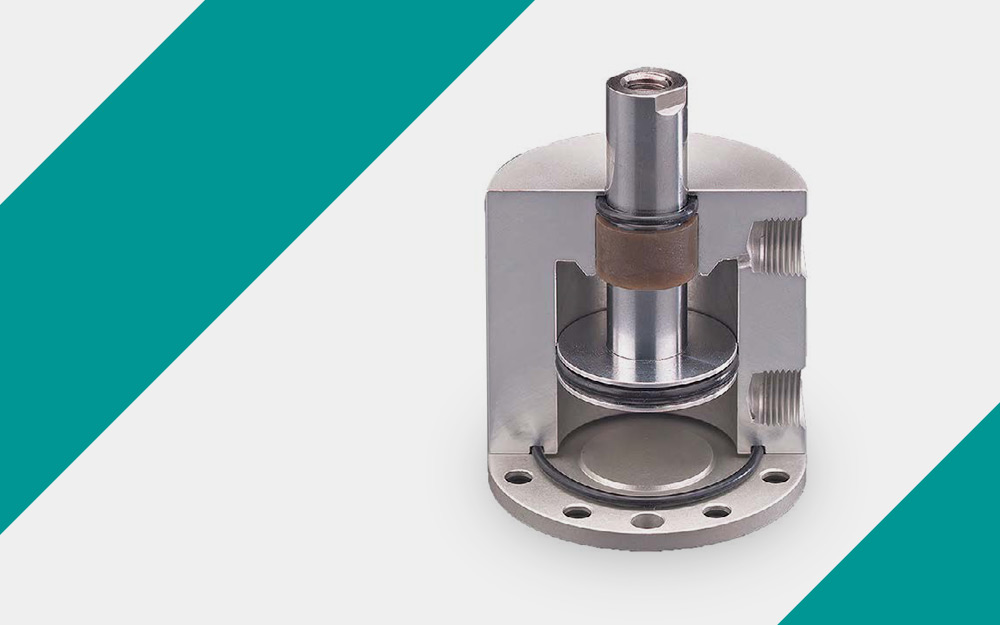Compact Air Cylinders: 101
More or Less – Compact Air Cylinders are a Big Deal! “Less is more” seems to be the trend in the pneumatic actuator market. Real estate on OEM equipment is at a premium today more than ever before! This just confirms that Alfred W. Schmidt (the founder of Fabco-Air, Inc.) was well ahead of the curve when he designed the original Pancake® (a registered trademark of Fabco-Air, Inc.) air cylinder in the late 1950’s. This particular type of pneumatic actuator was designed to satisfy the need for short stroke, low profile, compact air cylinders that were required to fit in very tight spaces. In fact, this cylinder type provides the longest stroke possible in the smallest overall envelope size. Approximately 6 decades later, compact air cylinders are still a big deal!
Today, compact cylinders using compressed air are most often the primary solution when space is limited and mechanical actuation is desired. A typical compact air cylinder is between the bore size range of ½” (12mm) to 4” (100mm) with standard strokes ranging from 1/16” (1.5mm) to 4” (100mm). With the typical maximum standard stroke of 4” (100mm), these cylinders are also frequently referenced as short stroke cylinders.

The original Pancake® is a bored body design as shown in the cutaway view in Figure 1. In addition to the bored body design, compact cylinders are now offered in a conventional tie-rod/spacer configuration in both a round and square design (Figure 2) as well as an extruded body designs (Figure 3).

Compact air cylinders have a piston rod configuration (as opposed to a rodless cylinder). Piston rod cylinders function in two ways: double-acting and single-acting. Double-acting cylinders (of which Figure 1 is an example) use compressed air to power both the extend and the retract stroke (moving the rod back and forth). This arrangement makes double-acting cylinders ideal for pushing and pulling loads. Here are some common double-acting, compact air cylinder application functions:
- Assembling
- Bending
- Clamping
- Feeding
- Forming
- Lifting
- Lowering
- Positioning
- Pressing
- Processing
- Punching
- Shaking
- Sorting
Single-acting cylinders have compressed air supplied to only one side of the piston; the other side vents to atmosphere. Depending on whether air is routed to the cap or rod end determines whether the rod extends or retracts. The most common type is pressure-extended with an internal spring returning the piston to its original position when air exhausts. This is typically called spring return. (Figure 4)

Spring extend is when air pressure retracts the rod and the spring force causes the rod to extend when pressure is removed. This makes single-acting cylinders ideal when a force is needed in one direction only and where the return stroke is unimpeded and unloaded. These are also popular in areas where, for safety reasons, a defined position must be taken in the event of a power failure. Here are some typical single-acting, compact air cylinder application functions:
- Actuating of Flaps and Levers
- Clamping
- Ejection
A single-rod configuration, as shown in each of the previous cylinder examples, is far and away the most common throughout the entire air cylinder industry. However, a double-rod cylinder design is quite useful in many applications.
Double rod cylinders are used: when equal displacement is needed on both sides of the piston, when the cylinder is required to perform work on both sides, when it is mechanically advantageous to couple a load to each end, or when the extra end can be used to mount cams for operating limit switches.
Enormous Range of Options
Short stroke cylinders might be compact in stature but the number of available models and options is huge!
Mounting
Compact air cylinders have many of the same type of mounts as the larger National Fluid Power Association (NFPA) and International Organization for Standardization (ISO) interchangeable cylinders. Here is an overview of typical short stroke cylinder mounting types and examples.
Centerline Mounting
The best support for an air cylinder is along the centerline of the cylinder. It is called centerline because the mounting plane is the centerline of the cylinder. This provides rigid support that requires accurate alignment.

Thru-hole mounting (Figure 7A) is available on many short stroke cylinder models. It provides counter-bored holes drilled through the cylinder body for easy mounting with socket head cap screws. Nose mounts (Figure 7B) as well as front and rear flange mounts (Figure 7C) are also offered on a variety of compact cylinder styles.

Pivot Mounting
In many applications, the cylinder must be allowed to pivot through an arc. Eye and clevis mounts (Figure 8) as well as trunnion mounts are available on many compact cylinder models.
Non-Centerline Mounting
These mounts are generally quite rugged but in some cases may be less rigid than the previously mentioned mounting types. Because the plane of the mounting surface is not through the centerline of the cylinder, a bending moment is created around the mounting points. None-the-less, side lug (Figure 9A) and foot mounted compact air cylinders (Figure 9B) are sometimes the perfect solution for unique applications.

Non-Rotating
For compact air cylinder applications in which anti-rotation and registration are critical, there are solutions. However, please keep in mind that all non-rotating options on compact/ short-stroke cylinders are for light torsional handling and, registration only. Maintaining the rod’s fixed orientation can be accomplished in several ways.
Double-Acting, Single-Rod (Internal Solution)
Figure 10 shows one method used on a bored body cylinder. Two guide pins incorporated inside the cylinder pass through the piston head. These guide pins prevent rotation of the rod with a usual tolerance of ±1°. A rubber disk is included at the end of each guide pin to take up end play and firmly seat the pins in the precision guide pin holes.
External Configuration
Another solution uses an external guide block securely attached to the piston rod. One or two steel guide shafts, attached to the guide block, assure anti-rotation of usually less than 0.8°.

Twin Rod and Tooling Plate Design
In Figure 12 below twin piston rods are incorporated into the cylinder head to provide anti-rotation. The rods are securely fastened to the piston and tied together externally by a rod end tool bar. The tooling plate ensures that the rods move in tandem and provides an ideal mounting surface for attachments required by your application. Tool bars are sometimes furnished with threaded mounting holes or optional counter-bored mounting holes.
Multiple Piston Offerings
Multiple pistons are used to increase thrust force of the cylinder. Multi-Power® (a registered trademark of Fabco-Air, Inc.) air cylinders (A.K.A. - multi-piston cylinders) provide the same output force as much larger bore, single piston cylinders. Higher forces can be achieved in tight spaces versus larger bore cylinders which require a larger footprint and center-to-center space when more than one cylinder is required. This technology has been incorporated into the compact cylinder segment as well. Figure 13A show a 4-stage force-multiplying compact cylinder. Figure 13B shows its extend function in a cross-sectioned view.

Multiple Positions to Provide Intermediate Positioning
If the application requires a compact style air cylinder as well as intermediate load position – standard solutions are available. Three or more rod positions can be achieved via a single cylinder! The most popular is the 3-position configuration.
Figure 14 shows a cross-sectioned view of an extruded body, 3-position cylinder in which the piston rods are shown partially extended for illustration purposes. The two cylinder bodies are coupled using two socket head cap screws. Piston rod ‘B’ extends through the cap end of the front cylinder and can push Piston ‘A’ as it extends. To set Position #1, imagine that both pistons are retracted; in Position #2 Rod ‘B’ extends moving Rod ‘A’ partially forward; Position #3 is reached when Rod ‘A’ is fully extended. You can see that Rod ‘A’ must be longer than ‘B’ in order to get three discrete positions with your cylinder.

Additional Relevant Options
Position Sensing
Standard electronic switches are a very popular option. All that is needed is the addition of an internal magnet attached to the piston! Many compact cylinders come standard with external grooves in their bodies for easy mounting and adjustment of sensors.
Extend Stroke Adjustment
Dial-A-Stroke® (a registered trademark of Fabco-Air, Inc.) provides a rugged and precision adjustment of the extend stroke of the cylinder. (Figure16) The stop tube, adjustment nut with skirt and minimum clearances combine to eliminate pinch points, thus providing operator safety.

Retract Stroke Adjustment
An adjusting screw with a thread sealing locknut mounted in the rear cover provides a simple yet rugged and precision adjustment of the cylinder stroke in the retract direction when the piston contacts the end of the screw. The fine thread of the adjusting screw provides precision adjustment.
Applications
Compact air cylinders are selected by their ability to perform a specific function. These functions are literally boundless. Here is just a sample of some common applications and industries that typically employ compact air cylinders:
- Aftermarket Automotive
- Animatronics
- Automotive Assembly
- Conveyor Systems
- Custom Built Machinery & Equipment
- Door and Window Frame Manufacturing
- Material Handling
- Packaging
- Palletizing
- Paper Converting
- Plastic Mold Machinery
- Printing
- Robotics
- Stamping and Forming
- Semiconductor Processing
Custom Compact Air Cylinders
The compact air cylinder market is loaded with option choices, configurations, permutations, and even brands. However, sometimes the job at hand simply falls outside the standard product offering and only a tailored or custom product will suffice. The development of custom compact air actuators can often be both expensive and time consuming, but may be the only solution for unique applications. In order to properly specify a compact air actuator for any application, it requires that two main questions be answered before moving into the heart of the design:
- What do I need the cylinder to do? (What type of work will it be performing?
- What type of cylinders do I have to select from?
If the ideal actuator is not found via the host of standard offerings, then the pursuit of a custom actuator might be a better solution!
SUMMARY
Roughly 6 decades after Fabco-Air, Inc. introduced the original Pancake® air cylinder, this cylinder type continues to play a huge part in moving the industrial world today! These short stroke cylinders are lengthy when it comes to styles, configurations, and options. For more information, reach out to the team at Higginson.
Download the original Fabco-Air TechTips ebook

